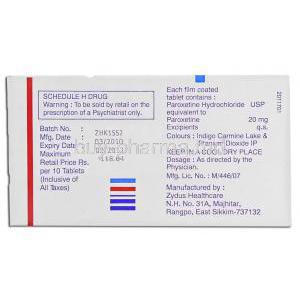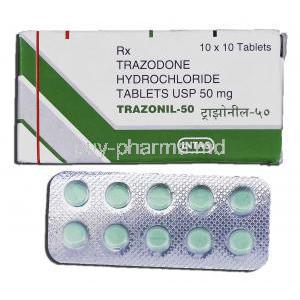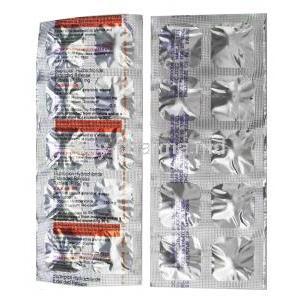1. Introduction
Overview of Xet (Paroxetine)
Xet, containing the active ingredient Paroxetine, is a potent antidepressant belonging to the class of selective serotonin reuptake inhibitors (SSRIs). It is primarily prescribed for the management of depressive and anxiety disorders by restoring the balance of serotonin, a neurotransmitter essential for emotional stability and well-being.
Classification: Selective Serotonin Reuptake Inhibitor (SSRI)
As an SSRI, Paroxetine functions by inhibiting the reabsorption of serotonin in the brain, enhancing serotonergic neurotransmission and improving mood regulation. This pharmacological classification distinguishes it from tricyclic antidepressants and monoamine oxidase inhibitors due to its improved tolerability and specificity.
Historical Background and Approval Timeline
Paroxetine was introduced in the late 1980s and gained global recognition following its FDA approval in 1992 for the treatment of major depressive disorder. Over the years, its indications expanded to include a range of anxiety-related conditions, solidifying its place as a cornerstone in modern psychopharmacology.
Brand Names and Global Availability
Paroxetine is marketed worldwide under various brand names such as Paxil, Seroxat, and Xet. Its availability in both immediate-release and controlled-release formulations allows for tailored treatment approaches across different healthcare systems.
2. Composition and Formulation
Active Ingredient: Paroxetine Hydrochloride
The therapeutic agent in Xet is Paroxetine Hydrochloride, a crystalline compound that modulates serotonin reuptake at the synaptic cleft, producing sustained antidepressant effects.
Available Strengths and Dosage Forms
- Tablets: 10 mg, 20 mg, 30 mg, and 40 mg
- Controlled-release tablets: 12.5 mg, 25 mg, and 37.5 mg
- Oral suspension: 10 mg/5 mL
Inactive Ingredients and Excipients
Typical excipients include magnesium stearate, calcium phosphate, microcrystalline cellulose, and sodium starch glycolate. These components ensure stability, dissolution uniformity, and optimal absorption.
Manufacturer-Specific Differences
Generic formulations may vary slightly in color, coating agents, or disintegration time. However, all are pharmaceutically equivalent in bioavailability and therapeutic potency.
3. Mechanism of Action
Overview of Serotonin Reuptake Inhibition
Paroxetine selectively binds to the serotonin transporter (SERT) on presynaptic neurons, blocking serotonin reuptake. This action elevates synaptic serotonin levels, leading to mood enhancement and reduction of anxiety.
Neurochemical Effects on Serotonin Pathways
Through prolonged serotonergic signaling, Paroxetine influences neuroplasticity, hippocampal neurogenesis, and cortical circuits involved in emotional regulation. The result is stabilization of affect and cognitive processing.
Impact on Mood, Anxiety, and Obsessive-Compulsive Regulation
Increased serotonin availability attenuates excessive neural firing in stress-related circuits, alleviating symptoms of depression, panic, and obsessive-compulsive behaviors.
Onset of Action and Time to Clinical Benefit
Therapeutic effects typically begin within 2–4 weeks, with full efficacy often achieved after 6–8 weeks of continuous therapy.
4. Therapeutic Uses
4.1. Major Depressive Disorder (MDD)
Xet is indicated for moderate to severe depression. It improves motivation, concentration, and overall mood. Expected outcomes: noticeable improvement in sleep, appetite, and emotional balance within several weeks.
4.2. Generalized Anxiety Disorder (GAD)
Paroxetine alleviates chronic anxiety, excessive worrying, and muscle tension by modulating serotonergic and limbic activity.
4.3. Panic Disorder
Regular use decreases the frequency and intensity of panic attacks, enhancing patients’ quality of life and daily functioning.
4.4. Social Anxiety Disorder (SAD)
Paroxetine improves social performance and reduces avoidance behavior by calming neural hyperactivity associated with social fear.
4.5. Obsessive-Compulsive Disorder (OCD)
Through persistent serotonin elevation, Xet reduces intrusive thoughts and repetitive actions that define OCD pathology.
4.6. Post-Traumatic Stress Disorder (PTSD)
Paroxetine diminishes re-experiencing phenomena, nightmares, and hyperarousal by restoring serotonergic equilibrium in stress-response circuits.
5. Off-Label Uses
- Premature ejaculation: delays ejaculation by increasing serotonin availability in ejaculatory control pathways.
- Menopausal hot flashes: provides non-hormonal relief from vasomotor instability.
- Premenstrual dysphoric disorder (PMDD): mitigates mood lability and irritability during luteal phases.
- Chronic pain and fibromyalgia: used as an adjunct for neuropathic modulation.
- Bipolar depression: occasionally co-administered with mood stabilizers under medical supervision.
- Migraine prophylaxis: may reduce attack frequency by influencing serotonergic vascular regulation.
6. Dosage and Administration
6.1. Standard Adult Dosage
Typical initiation is 20 mg once daily, with gradual titration to a maximum of 50 mg for depressive or anxiety disorders. The dose may vary based on individual response and tolerability.
6.2. Pediatric Administration
Although not widely approved for pediatric depression, it may be used cautiously in adolescent OCD under specialist guidance, typically starting at 10 mg/day.
6.3. Elderly and Renal/Hepatic Impairment Adjustments
Reduced metabolic clearance necessitates a lower starting dose (10 mg daily). Monitoring of sodium levels and adverse effects is essential.
6.4. Administration Guidelines
- Take with or without food, preferably in the morning to avoid insomnia.
- Missed doses should be taken as soon as remembered, unless it is near the next scheduled dose.
- Discontinuation should be gradual to prevent withdrawal symptoms such as dizziness or sensory disturbances.
7. Pharmacokinetics and Pharmacodynamics
Paroxetine is well absorbed after oral administration, achieving peak plasma levels within 5–6 hours. It undergoes hepatic metabolism primarily via CYP2D6 isoenzyme and is excreted in both urine and feces. The elimination half-life averages 21 hours, supporting once-daily dosing. Protein binding exceeds 90%, ensuring sustained pharmacologic effect.
8. Side Effects
8.1. Common Side Effects
- Nausea, mild gastrointestinal discomfort
- Insomnia or daytime somnolence
- Dry mouth, sweating, dizziness
- Sexual dysfunction including delayed orgasm
- Weight gain or loss over prolonged therapy
8.2. Serious Adverse Reactions
- Suicidal thoughts, particularly during initial treatment weeks
- Serotonin syndrome with hyperreflexia, agitation, and hyperthermia
- Severe hyponatremia, especially in elderly or diuretic users
- QT interval prolongation and potential arrhythmia
8.3. Long-Term Effects
Chronic administration may lead to emotional blunting or apathy in some individuals. Discontinuation syndrome—characterized by flu-like sensations and sleep disturbance—can occur if stopped abruptly.
9. Drug Interactions
- MAO inhibitors: absolute contraindication due to risk of hypertensive crisis and serotonin syndrome.
- Other serotonergic agents (SSRIs, SNRIs, triptans): increased serotonergic toxicity risk.
- Warfarin and anticoagulants: heightened bleeding tendency.
- Tamoxifen: reduced efficacy owing to CYP2D6 inhibition by Paroxetine.
- Alcohol and CNS depressants: enhanced sedation and psychomotor impairment.
- Herbal supplements: St. John’s Wort and tryptophan can precipitate serotonin excess.
```html
10. Warnings and Precautions
Suicidality Risk in Young Adults and Adolescents
Paroxetine, like other antidepressants, has been associated with an increased risk of suicidal ideation and behavior, particularly in young adults under the age of 25. Close observation is essential during the initial treatment period or after dose adjustments. Healthcare providers should maintain vigilant monitoring for mood shifts, agitation, or unusual behavioral changes.
Abrupt Discontinuation and Withdrawal Syndrome
Sudden cessation of Paroxetine may provoke withdrawal symptoms such as dizziness, sensory disturbances, irritability, anxiety, or insomnia. A gradual tapering strategy is strongly recommended to mitigate discontinuation reactions and maintain neural equilibrium.
Monitoring for Mania or Hypomania Activation
In patients with bipolar disorder, antidepressant therapy may precipitate a switch to manic or hypomanic states. It is crucial to screen for a history of mania prior to initiation and to discontinue the drug if manic symptoms emerge.
Caution in Seizure Disorders
Paroxetine may lower the seizure threshold. Individuals with epilepsy or seizure history require dose adjustment and consistent neurological monitoring. Therapy should be discontinued in patients experiencing new or increased seizure activity.
Impact on Driving and Psychomotor Performance
Drowsiness, dizziness, and blurred vision can occur during treatment. Patients should avoid operating heavy machinery or driving until they understand how the medication affects their alertness and coordination.
11. Contraindications
Known Hypersensitivity to Paroxetine or Excipients
The use of Xet (Paroxetine) is contraindicated in individuals with known hypersensitivity reactions such as rash, angioedema, or anaphylaxis to Paroxetine or its inactive components.
Concurrent Use with MAO Inhibitors or Linezolid
Co-administration with monoamine oxidase inhibitors or the antibiotic linezolid is strictly contraindicated due to the potential for life-threatening serotonin syndrome. A minimum washout period of 14 days should be observed when switching between these agents.
Severe Hepatic Impairment
Patients with marked hepatic dysfunction may experience reduced metabolism of Paroxetine, leading to toxic accumulation. Use is contraindicated unless under close specialist supervision.
Pregnancy and Lactation Unless Benefits Outweigh Risks
Paroxetine should be avoided during pregnancy unless no safer alternatives are available. Fetal cardiac malformations and neonatal withdrawal have been reported. During lactation, the drug may pass into breast milk and affect the infant.
12. Careful Administration and Important Precautions
Monitoring in Patients with Cardiovascular Disease or Diabetes
Paroxetine can influence blood pressure, glucose tolerance, and heart rate. Patients with preexisting cardiovascular conditions or diabetes require frequent monitoring and dosage adjustment to ensure stability.
Use in Patients with Bleeding Disorders or on Antiplatelet Therapy
SSRIs, including Paroxetine, can impair platelet aggregation. Patients on anticoagulants, aspirin, or NSAIDs should be closely observed for bruising, nosebleeds, or gastrointestinal hemorrhage.
Gradual Dose Escalation to Reduce Adverse Reactions
Titration should be gradual to minimize nausea, agitation, and insomnia. Slow dose increments help optimize tolerance and improve adherence.
Periodic Assessment of Mental Status and Suicidality
Ongoing psychiatric evaluation is crucial to assess therapeutic response and detect emergent suicidal tendencies or behavioral abnormalities.
13. Administration in Special Populations
13.1. Use in Elderly Patients
Elderly patients are more prone to adverse effects such as hyponatremia, dizziness, and falls. Renal and hepatic functions decline with age, necessitating dosage reduction and careful electrolyte monitoring. Regular assessments can help prevent complications associated with drug accumulation.
13.2. Use in Pregnant Women
Exposure during the first trimester has been linked to potential congenital anomalies, particularly cardiac defects. Newborns exposed in the third trimester may experience withdrawal symptoms—respiratory distress, feeding difficulty, and irritability. The risk-benefit ratio must be meticulously evaluated for each case, especially in women suffering from severe perinatal depression.
13.3. Use in Nursing Mothers
Paroxetine is excreted in breast milk in measurable quantities. Although serum levels in infants are typically low, monitoring for irritability, feeding issues, or somnolence is advised. Alternative antidepressants with lower milk penetration may be preferred.
13.4. Use in Children and Adolescents
Paroxetine carries a black box warning for increased risk of suicidal thinking in individuals under 18 years. Use should be restricted to specific indications such as obsessive-compulsive disorder, and therapy must be conducted under strict psychiatric supervision.
14. Overdosage and Management
Symptoms
Overdose may manifest as vomiting, tremor, tachycardia, confusion, severe agitation, or coma. Cardiac arrhythmias and seizures are possible in extreme cases.
Emergency Management and Supportive Care
There is no specific antidote for Paroxetine overdose. Treatment is primarily supportive, focusing on maintaining airway patency, adequate oxygenation, and cardiovascular stability.
Activated Charcoal and Gastric Lavage Considerations
If ingestion occurred within one hour, administration of activated charcoal or gastric lavage may reduce absorption. Induced emesis is not recommended due to aspiration risk.
Monitoring for Cardiac and CNS Complications
Continuous ECG monitoring is essential for detecting QT prolongation or arrhythmias. Neurological assessment should continue until full recovery.
15. Handling and Storage
Recommended Storage Temperature and Moisture Protection
Store Paroxetine tablets below 30°C in a dry environment, protected from direct sunlight and humidity. Keep in the original blister pack until use to preserve potency.
Disposal of Unused or Expired Medication
Unused or expired medication should not be flushed or discarded in household waste. Return to a pharmacy or approved disposal facility to prevent environmental contamination.
Handling Precautions for Healthcare Providers
Healthcare workers should handle tablets with dry hands and avoid crushing or splitting unless indicated, as this may alter release kinetics.
16. Clinical Monitoring and Follow-up
Regular Assessment of Mood and Symptom Improvement
Routine evaluations help determine efficacy and guide dose adjustments. Patients should report persistence or worsening of depressive symptoms promptly.
Laboratory Monitoring in Long-Term Therapy
Periodic assessment of liver enzymes, serum sodium, and renal function is advised, especially for long-term users or those with comorbid conditions.
Counseling and Adherence Strategies
Comprehensive patient education enhances treatment compliance. Encouraging consistency in timing and explaining possible side effects fosters trust and long-term success.
17. Patient Education and Counseling Points
Importance of Adherence and Consistent Timing
Daily intake at the same hour helps maintain stable plasma concentration and therapeutic effectiveness. Skipping doses can compromise efficacy and trigger withdrawal symptoms.
Avoiding Alcohol and Abrupt Discontinuation
Alcohol may potentiate sedation and cognitive impairment. Abrupt cessation can cause discontinuation syndrome; therefore, dose tapering under medical supervision is crucial.
Recognizing Early Signs of Adverse Effects
- Agitation, restlessness, or emotional instability
- Severe headache or palpitations
- Muscle rigidity or confusion suggesting serotonin syndrome
Gradual Dose Reduction Under Medical Supervision
When discontinuing therapy, gradual reduction over several weeks prevents rebound symptoms and physiological disturbances. Medical oversight ensures a safe and effective transition off treatment.
```










